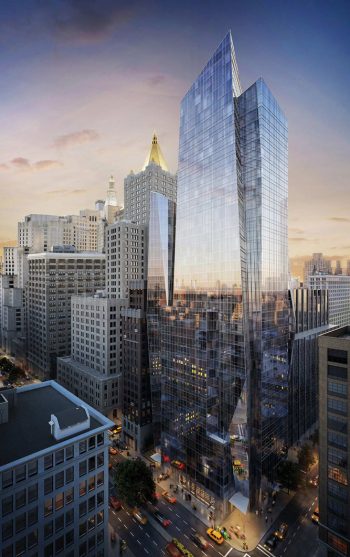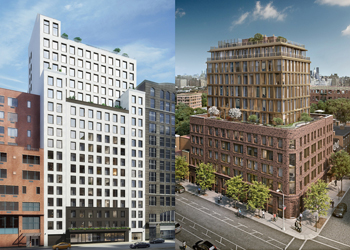In December 2015, with new development sales beginning to drag, Doug Yearley got poetic about condo sales – or the lack thereof.
“There are certain units in certain locations within a building that are hot, and then there are other units that may be in a dark, cold corner that you have to incentivize a bit more,” the CEO of national homebuilding giant Toll Brothers told investors during an earnings call at the time.
Since then, Toll Brothers has rolled out an aggressive array of incentives at its condo projects in New York, becoming one of the biggest players to acknowledge the slowdown and spell out its plans to tackle it. And in planning for the future, it’s shifted away from the top-tier luxury product that has saddled so many developers with unsold inventory.
“They have so much product, they’re trying to see where they can get traction and velocity of sales, which is smart on their end,” said Corcoran Group’s Tamir Shemesh, who is marketing Toll’s 81-unit condominium at 400 Park Avenue South. Shemesh said he sold five apartments at 400 PAS since mid-February, when the developer announced it would cover mansion and transfer taxes at select buildings. (400 PAS wasn’t one of them, but the offer generated more sales-office traffic anyway.)
“They’re more visible to the brokerage community and buyers,” Shemesh said. “That’s good for them.”
Toll said traffic was up 20 percent at buildings where it offered to pay buyers’ taxes — results that prompted the homebuilder to extend the offer again: Between April 8 and 30, Toll will again cover mansion and transfer taxes at 100 Barrow Street, 55 West 17th Street and the Sutton, at 959 First Avenue. Last year, Toll also rolled out a year-long broker incentive, giving brokers an extra 0.5 percent commission for each subsequent deal in a Toll building. The developer has also offered discounts at 400 PAS and 1110 Park Avenue.
“As everyone knows, there’s more supply than there has been in previous years, so we want to help distinguish ourselves and get people in the door,” said David Von Spreckelsen, president of Toll Brothers City Living, the company’s upscale urban development division that’s heavily invested in New York. “Part of it is, you want to get traffic,” he said.
With the initiatives, Toll is trying to address the pain felt by a wide variety of condo builders here. During the first quarter of the year, new development sales in Manhattan dropped 25.4 percent to 463, according to appraisal firm Miller Samuel. During the same time, the overall number of sales dipped just 0.5 percent to 2,892.
While price adjustments and incentives can bring buyers to the table, Miller Samuel’s Jonathan Miller said buyers are increasingly holding out for price cuts. “We are probably beyond the incentives-only stage,” he said.
This slowdown has been a drag on City Living’s earnings. In fiscal year 2016, City Living revenue dipped 18.5 percent to $257.5 million, as the number of closed sales fell to 91 from 219. Meanwhile, the average price of closed sales jumped to $2.8 million from $1.4 million.
“They got a little aggressive on their pricing,” said Stephen Kliegerman of Terra Holdings, which owns Brown Harris Stevens and Halstead Property, and doesn’t work with Toll Brothers. “One of the negatives of doing your own in-house sales and marketing is you don’t have boots-on-the-ground brokers to say to decision-makers: ‘You’re going a little too far.’”
But Elizabeth Ann Stribling-Kivlan, president of Stribling & Associates, called the incentives a proactive and “very wise” move. “It shows a commitment to selling your product and adapting to the market,” said Stribling-Kivlan, who bought a $2.9 million condo at Toll’s Pierhouse development in Brooklyn earlier this year. “In a very competitive and changing market in New York, the candor is very important.”
Toll Brothers moved into big-city condo development in 2003, when Yearley — then a senior vice president at the firm — started the City Living division in New Jersey. A year later, Von Spreckelsen and Rick Hartman, who is now Toll’s president, got the division going in New York.
The business accounted for nearly 5 percent of Toll’s $5.17 billion revenue in fiscal 2016, according to Toll’s annual report. It’s a small slice of Toll Brothers’ business, but a rewarding one — City Living generated gross margins of 41 percent in 2016.
Brian Bernard, an analyst at Morningstar who follows Toll Brothers, said City Living has also been a way for the company to diversify its sales and distinguish itself from the competition.
With the exception of Lennar Corp., Toll is the only firm doing multifamily development, he said. “All the other guys are, for the most part, pure-play homebuilders,” according to Bernard, who said Toll is also poised to capitalize on first-time buyers. “Millennials will eventually move to home ownership; they’re better positioned for that,” he said.
Von Spreckelsen put it this way: “It helps when one segment of the real estate market may be slower, to have a full product line and stay busy all the time.”
City Living’s projects range from 50 to 200 units, with target prices between $2,000 and $2,500 per square foot. The developer is actively selling seven buildings in New York, where 254 units out of 516 units remained unsold as of January 31, according to investor documents.
Toll has two additional projects in the pipeline, a 111-unit condo at 91 Leonard Street and 77 Charlton Street, which will have two 15-story buildings with 162 units combined. Sales haven’t yet launched at those projects.
Von Spreckelsen said the New York market is still strong, even though sales have slowed since the frenzied buying of 2014 and 2015. “We’re still very bullish,” he said, noting that in February, a penthouse at Pierhouse sold for $10.6 million. “It’s just there’s more supply than there had been, so you have to be more patient,” he said.
One area in which Toll has exercised extreme caution is dirt.
The homebuilder spent $284.5 million on five land acquisitions in 2012, according to data from research firm Real Capital Analytics. It picked up another six properties between 2012 and 2015, but hasn’t done a land deal since. Von Spreckelsen said Toll snagged some bargains coming out of the recession, and condos at those sites are on the market now.
That was the case at 100 Barrow, which brokers have called a somewhat risky move. In 2015, Toll signed a 99-year ground lease with Church of St. Luke in the Fields in a deal that will generate $800 million for the church over the term of the deal, according to prior reports. Toll, which is developing a 33-unit co-op at the site, said the payments will be tied to market conditions.
“In many ways, Toll Brothers acquired significant risk by participating in this project,” Paul Wolf, a principal at brokerage Denham Wolf, wrote in a summary of the deal submitted for the Real Estate Board of New York’s Ingenious Awards. In exchange, he said, developer gained the opportunity to build a 75,000-square-foot development in a neighborhood that “rarely sees the opportunity for new construction.”
But Morningstar’s Bernard said Toll hasn’t been opportunistic on land lately, and that’s weighed down investors’ returns.

400 Park Avenue South
“There’s a lot of invested capital that’s just sitting on their balance sheet,” he said.
To free up cash, though, the company has partnered on big projects like Pierhouse, where it teamed up with Starwood Capital, and 400 PAS, the rental-condo tower it’s developing with Sam Zell’s Equity Residential. This past December, Toll brought on a partner, Gemdale Properties, at its 133-unit condo project at 121 East 22nd. By bringing on a JV partner, the company slashed its equity commitment to $30 million from $350 million.
“It freed up a bunch of cash that we can use in New York or elsewhere,” Von Spreckelsen said. With so much liquidity, Toll Brothers is able to pounce on development sites when they arise, he added. “We’re well capitalized and when we find it, we’ll buy it.”

